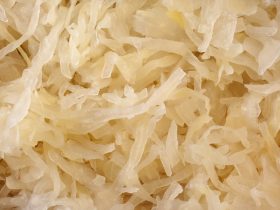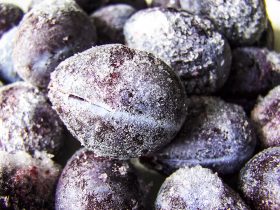Lettuce is a leafy-green vegetable originating in the same taxonomic family as daisies and sunflowers1. Owing to its relative ease at being cultivated and farmed, lettuce is available in nearly every country on Earth.
Though lettuce is an excellent source of nutrition, it can also spoil extremely quickly. Proper care must be taken to store bushels of lettuce in order to prevent food poisoning.
Lettuce should only be frozen in specific situations. If you are planning to use your lettuce as a salad base or for similar uses in its raw form, freezing the lettuce will completely ruin its quality, resulting in a formless ball of sludge. Lettuce may be frozen if you intend to use it for cooking or other purposes that do not involve using the raw leaves.
How Long Does Lettuce Last Out in the Open?
Owing to the extremely high water content of lettuce as well as the nature of all natural produce, lettuce lasts a very short amount of time when left on your countertop. According to a joint study conducted by the U.S. Department of Agriculture, lettuce leaves will only last an approximate two hours when left at room temperature or higher2.
Should you accidentally leave your lettuce in a warm environment with no other forms of preservation, it is best to inspect it for signs of spoilage before consuming.
Can Lettuce be Kept in the Fridge?
As keeping lettuce in the freezer is not advisable should you wish to use it in its raw form, it is then suggested that the ideal way to store lettuce is instead to place it within the refrigerator.
Your lettuce will last an approximate five to seven days depending on how long it has been exposed to the elements prior to refrigerating.
In order to store the lettuce within the fridge, you will need either a damp cloth or tissue as well as a resealable plastic bag large enough to contain the entire lettuce head with space to spare.

Storing Lettuce in the Refrigerator
After washing and drying the lettuce leaves, place the damp tissue or cloth along the length of the plastic bag and carefully place the lettuce head within the bag. Ensure that no leaves are being manually crushed by the sides of the bag or by other leaves, as this will cause them to liquify and hasten decomposition of the entire head.
Note that this is only in refrigerators that are at an average temperature of 40° F, too far above and spoilage may occur, too far below and cell-wall rupturing will take place.
Can Lettuce be Frozen Without Ruining it?
As previously mentioned in this article, freezing lettuce in its raw form will damage or entirely alter its quality. The physico-chemical reasons behind this are simply the rapid crystallization and expansion of water within and around cells.
Once the lettuce cells have been sufficiently damaged, they will no longer retain their shape, and as such contribute to a loss of taste and texture3.
Knowing this, it is still entirely possible to freeze your lettuce leaves, though not without compromising on their quality. It is recommended that you only freeze lettuce should you wish to use it in dishes like shakes or sauces.
Will Lettuce Lose Quality When Preserved Out of the Freezer?
The unfortunate truth is that, yes, lettuce will still deteriorate rapidly, even when stored properly within the fridge. Like most fresh produce, lettuce are subject to bacterial colonization as well as their own enzymatic actions, which can only be slowed down by reduced temperatures.
Equipment Needed to Freeze Lettuce
A paring knife, several resealable plastic bags or freezer bags, and a freezer are all that is needed to freeze lettuce.
Freezing the Lettuce
First, wash your lettuce as thoroughly as possible. Even if it was purchased pre-washed in a sealed container, it is best to wash it once more in order to remove any dirt or insects that may be present.
Once washed, use your paring knife to carefully remove the stalks from the leaves, as well as any unusual spots that may show signs of early spoilage. Place the freshly cut leaves onto a drying towel or sheaf of tissues in order to minimize surface moisture as much as possible.
Divide the leaves into as many portions as you have bags. It is important to minimize crushing of the leaves within the bags, as this will only further the damage done to them.
After dividing the leaves and placing them within the bags, gently remove any excess air within and place them in the freezer. Be careful to keep the bags of lettuce away from anywhere they may be pressed upon, such as beneath other containers in your freezer.
Alternative Ways to Freeze Lettuce
In the event that you wish to freeze your lettuce for shakes or dips, it is possible to simply blend the lettuce in a food processor or blender before placing it within an air-tight container and freezing for up to two weeks.
Because this process already liquifies the lettuce, there is very little need to worry of a loss in quality from freezing.
In order to thaw the pureed lettuce, simply place within the fridge overnight or until it returns to its original form.
Signs of Spoilage in Lettuce
Unlike certain other forms of fresh produce, signs of spoilage in lettuce are immediately visible. Any off-color patches along the edges of the leaves, or even dark slime should immediately warrant disposal of the lettuce.
Less clearly is the presence of any sort of smell. As lettuce does not have any sort of identifiable odor, the presence of one should indicate the beginnings of purification.
Should your lettuce display none of these signs despite having been purchased over two weeks prior, it is still wise to dispose of it.
References:
1. Unknown Authors. (December 2019). Lettuce, cos or romaine, raw U.S. Department of Agriculture https://fdc.nal.usda.gov/fdc-app.html#/food-details/746769/nutrients
2. Yaguang Luo, Arvind Bhagwat. (July 2008). Safe Leafy Greens—Before & After Bagging. Agricultural research magazine
3. G.H. Krause et al, (1988) Effects of freezing on plant mesophyll cells, Symposia of the Society of Experimental Biology PMID: 3077862





Hi, I'm Dom
Dom Eats was started to help other people fall in love with food. While cooking can feel intimidating, it doesn't have to be.